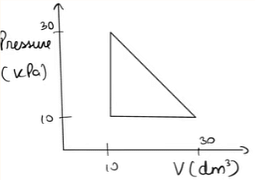Decreasing order of electron gain enthalpy of the following elements (magnitude only)
Sulphur A, Bromine - B, Fluorine C, Argon D
Sulphur A, Bromine - B, Fluorine C, Argon D
- A>B>C>D
- D>C>B> A
- C>B>A>D
- A>B>D>C
The Correct Option is C
Solution and Explanation
The correct option is (C): \(C>B>A>D\)
Top Questions on Enthalpy change
- Arrange the following elements in increasing order of first ionization enthalpy:
Li, Be, B, C, N
Choose the correct answer from the options given below:- NEET (UG) - 2024
- Chemistry
- Enthalpy change
- Find the work done in the following cyclic process (in J)

- JEE Main - 2024
- Chemistry
- Enthalpy change
If standard enthalpy of vaporization of \(CCl_4\) is \(30.5\) kJ/mol, find heat absorbed for vaporization of \(294 \) gm of \(CCl_4\). [Nearest integer] [in kJ/mol]
- JEE Main - 2024
- Chemistry
- Enthalpy change
- At $25^{\circ} C$, the enthalpy of the following processes are given: $H _2( g )+ O _2( g ) \rightarrow 2 OH ( g ) \Delta H ^{\circ} =78 \,kJ \,mol ^{-1} $ $H _2( g )+1 / 2 O _2( g ) \rightarrow H _2 O ( g ) \Delta H ^{\circ} =-242 \,kJ \,mol ^{-1} $ $H _2( g ) \rightarrow 2 H ( g ) \Delta H ^{\circ} =436\, kJ \,mol ^{-1} $ $1 / 2 O _2( g ) \rightarrow O ( g ) \Delta H ^{\circ} =249\, kJ\, mol ^{-1}$ What would be the value of $X$ for the following reaction?______ (Nearest integer) $H _2 O ( g ) \rightarrow H ( g )+ OH ( g ) \Delta H ^{\circ}= X\, kJ\, mol -1$
- JEE Main - 2023
- Chemistry
- Enthalpy change
- Enthalpies of formation of $CCl _4( g ), H _2 O ( g ), CO _2( g )$ and $HCl ( g )$ are $-105,-242,-394$ and $-92\, kJ$ mol $^{-1}$ respectively The magnitude of enthalpy of the reaction given below is ___$kJ \, mol ^{-1}$ (nearest integer) $CCl _4( g )+2 H _2 O ( g ) \rightarrow CO _2( g )+4 HCl ( g )$
- JEE Main - 2023
- Chemistry
- Enthalpy change
Questions Asked in JEE Main exam
- Find the acceleration of \(2\) \(kg\) block shown in the diagram (neglect friction)

- JEE Main - 2024
- Acceleration
- If \(|2A|^3 =21\) and \(\begin{bmatrix} 1 & 0 & 0 \\[0.3em] 0 & α & β \\[0.3em] 0 & β & α \end{bmatrix}\), then a is (if \(α,β∈I\))
- JEE Main - 2024
- Matrices
- Let \(α\) and \(β\) the roots of equation \(px^2 + qx - r = 0\), where \(P≠ 0\). If \(p,q,r\) be the consecutive term of non constant G.P and \(\frac{1}{α} + \frac{1}{β} = \frac{3}{4}\) then the value of \((α - β)^2\) is:
- JEE Main - 2024
- Geometric Progression
- Two lines \(L_1 \;\& \;L_2\) passing through origin trisecting the line segment intercepted by the line \(4x + 5y = 20\) between the coordinate axes. Then the tangent of angle between the lines \(L_1\) and \(L_2\) is
- JEE Main - 2024
- Tangents and Normals
- Rank of the word 'GTWENTY' in dictionary is _____ .
- JEE Main - 2024
- permutations and combinations
Concepts Used:
Enthalpy change
Enthalpy Change refers to the difference between the heat content of the initial and final state of the reaction. Change in enthalpy can prove to be of great importance to find whether the reaction is exothermic or endothermic.
Formula for change in enthalpy is:-
dH = dU + d(PV)
The above equation can be written in the terms of initial and final states of the system which is defined below:
UF – UI = qP –p(VF – VI)
Or qP = (UF + pVF) – (UI + pVI)
Enthalpy (H) can be written as H= U + PV. Putting the value in the above equation, we obtained:
qP = HF – HI = ∆H
Hence, change in enthalpy ∆H = qP, referred to as the heat consumed at a constant pressure by the system. At constant pressure, we can also write,
∆H = ∆U + p∆V
Standard Enthalpy of Reaction
To specify the standard enthalpy of any reaction, it is calculated when all the components participating in the reaction i.e., the reactants and the products are in their standard form. Therefore the standard enthalpy of reaction is the enthalpy change that occurs in a system when a matter is transformed by a chemical reaction under standard conditions.



